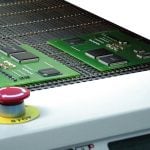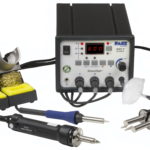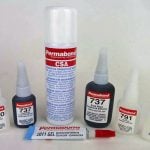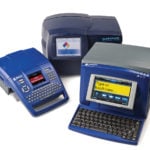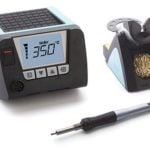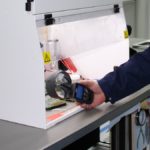Table of Contents
Soldering for Electronics | Solder, Flux, and Stencils
A printed circuit board stencil is a thin sheet of material (typically stainless steel) with a series of apertures (holes) cut into it which suit the PCB to be printed.
Solder powder is made of ultrafine metallic particles. The powder sizes are rated on a scale in which the lowest number is the largest size (in microns).
Flux removes surface oxides which creates a nice, clean surface for an intermetallic bond.
Solder paste is the combined result of solder powder and flux in a molten state. Alloy powder represents up to 90% of the mass of the solder paste.
Solder Paste Sizes for SMT Printing
The most common solder paste powder sizes for SMT are type 3 (T3), type 4 (T4), and type 5 (T5). The lower the number, the larger the particle size within the solder powder.
| Powder Size Chart | ||||
|---|---|---|---|---|
| Powder Type | Powder Size (Micron) | Gullwing Lead Pitch (mm) | Square/Circle Aperture (mm)/(in) | Dispense Dot Dia. (mm)/(in) |
| II | 45-75µ | 0.65 / 0.025 | 0.65 / 0.025 | 0.80 / 0.030 |
| III | 25-45µ | 0.50 / 0.020 | 0.50 / 0.020 | 0.50 / 0.020 |
| IV | 20-38µ | 0.30 / 0.012 | 0.30 / 0.012 | 0.30 / 0.012 |
| V | 15-25µ | 0.20 / 0.008 | 0.15 / 0.006 | 0.25 / 0.010 |
| VI | 5-15µ | 0.10 / 0.004 | 0.05 / 0.002 | 0.10 / 0.004 |
Considerations for Solder Mesh Sizes
Because components, packaging, and solder connections keep getting smaller, it’s harder to fill the apertures with the required amount of solder paste. Because type 3 solder paste is too large for accurate and repeatable with fine pitch components, demand grows for smaller T4 and T5 solder powders.
“T3 solder paste, will fall through a 325 mesh screen but not through a 500 mesh screen, hence the term -325+500.”
“Spheres categorized as Type 3, or T3, will fall through a 325 mesh screen but not through a 500 mesh screen, hence the term -325+500. This equates to particle sizes of 25 to 45µm; 80% of the particles must meet this size requirement.”
“Likewise, Type 4 solder paste will fall through a 400 mesh screen but not a 635 mesh screen, equating to particle sizes of 20 to 38µm. There is a lot of size overlap between the T3 and T4 solder powder classes; therefore, T4 solder paste can typically offer a slight edge in fine feature printing without presenting substantial reflow concerns.”
(AIM Solder)
Solder Paste – Type 3 vs Type 4 vs Type 5
Type 4 or 5 solder pastes improve solder paste application for smaller components. This is especially true when these solder pastes are coupled with new, high-performance stencil technologies.
“In general, Type 5 gives higher transfer efficiency than Type 4 solder paste, and Type 4 gives higher transfer efficiency than Type 3 solder paste. At smaller area ratios, this difference in transfer efficiency becomes less distinct.”
“T4 solder paste can typically offer a slight edge in fine feature printing without presenting substantial reflow concerns. T5 solder offers better print resolution but more volatility compared to type 3 solder in terms of paste ball size, shelf life, and chemical reactivity (higher potential for oxidation).”
FTC Solder
Type 3 Solder Paste Applications
- 0402 imperial package size
- Stencil designs with area ratios above 0.66 (IPC limit)
“The largest particle in a Type 3 paste is 1.7 mils. The five-ball rule says that the smallest aperture I should use with that paste is at least as big as five times the diameter of the largest particle, which means for a Type 3 paste, that would be an 8.5 mil aperture.
Anything smaller than that, five-ball, the largest particles would not span across that aperture and that’s an indicator of the ability of the paste to easily flow in and out of the aperture. Type 4 has a smaller particle size. Its largest particle is 1.5 mils, so it can go down to an aperture of 7.5 mils.”
Circuitinsight.com – Jim Hall
Type 4 Paste Applications
Used when referring to surface-mount components with a lead pitch of 25 mils or less.
- Stencil with area ratios below the recommended IPC limit of 0.66
- 0.5mm BGAs | Micro BGAs
- 0201 imperial and similar components
- Most SMT applications
Type 5 and Type 6 Solder Paste
- QFNs,
- µBGA
- 01005 passive devices
- Imperial components
Applications
Type T5 and T6 solder paste are common for solder dispensing when the solder is deposited from a single point of extrusion rather than squeegeed over a stencil.
- Ultra-fine-feature applications
- Dispensing
- Jet printing
Cons of Smaller Powder Sizes:
There are some potential downsides to smaller solder powder sizes:
- May shorten stencil life
- Susceptible to solder balling and graping
- Decreased solder powder size requires more flux, flux may run out of activity
- More susceptible to oxidation and chemical reactivity
Solder Paste for Dispensing
Soldering paste for dIspensing must pass through a small dispensing tip, sometimes as small as a needle. Compared to production solder paste, dispensing solder paste improves the flow rate.
A broad line of soldering applications may include manual dispensing, semi-automated / machine-assisted, or entirely automated dispensing robots and conveyor systems.
Hand dispensing combines unique tube sizes such as 10CC, 30CC, 60CC, with tip diameters appropriate for deposition rate and workflow.
AIM & Kester Solder: Get Help from a PAC Specialist

The things you’ll want from any distributor of fluid dispensing are service and background expertise. Ask for advice from a PAC specialist for support of Kester solder paste and AIM solder paste.
PAC (that’s us) is a distributor and factory-direct representative for thousands of soldering products including AIM and Kester solder paste. Aim solder paste part numbers are derived with relation to the sphere size such. For Kester soldering products, the product name includes the powder size (T3, T4, T5).
“The sphere size, deposition rate, and ratio of flux are important factors for determining the quality of intermetallic bonds during SMT manufacturing. When the component goes through the oven, too much flux could cause the component to float away. Not enough flux and solderability is poor. Ideally, the flux is portioned so that it completely activates and deactivates.”
Marshall Canaday – PAC Soldering Applications Specialist – gotopac.com (Contact)
Do I Need a Smaller Solder Paste Size?
Type 3, 4, 5 and 6 solder paste categories address most demand for SMT and dispensing related soldering.
When facing printing problems with features of 10 mils (0.25mm) diameter or larger, the most effective approach is to audit the process itself to ensure it is stable and optimized.
PAC can help with process audits, and let you know if a move to a finer powder or improved stencil technology is warranted.
Solder, Flux & Consumables
PAC is an authorized distributor for AIM and Kester soldering paste, solder bar, and flux products.
Shop gotopac.com or call for help from a PAC soldering and dispensing specialist.
Related Posts
-
The Difference Between Solder Fume Extractors & Smoke Absorbers
Here you'll learn about soldering fans, fume absorbers, and fume extractor applications. Some may require a fan for soldering while others need a more advanced solution for laser engraving, solvent use, or 3D printing. It's…
-
Dispensing: Recycle or Replace?
The most popular dispensing technique used in the manufacturing process is time and pressure dispensing (TPD) from a syringe barrel. This method became popular because if the low-cost, simple setup and lack of required maintenance.…
-
Dispensing: Recycle or Replace?
The most popular dispensing technique used in the manufacturing process is time and pressure dispensing (TPD) from a syringe barrel. This method became popular because if the low-cost, simple setup and lack of required maintenance.…
-
How Dry Cabinets Solve Moisture Problems During SMT Reflow
An Alternative Drying Solution Replaces Traditional Methods As the industry utilizes a high-temperature reflow process, moisture sensitivity in SMT remains a constant problem. Serious manufacturing defects and failures are much more likely to occur later…
-
Stencil Wipe Rolls - New Understencil Wiping Rolls for SMT DEK EKRA MPM Printing
Polymeric resin-bonded stencil wipes encourage solder paste and adhesive retention. The fabric density performs better under vacuum than paper-based products. Air is able to pass through the microstructures and permit uniform contact with the board…
-
Here's What You Need to Know About Soldering Your Broken Electronics
A few tips for learning how to fix broken electronics with a soldering iron the right way, the first time.
-
Permabond Anaerobic Adhesives & Sealants
For Threadlocking, Pipe Sealing, Gasketing, and Retaining By definition, anaerobic adhesives remain liquid until isolated from oxygen in the presence of metal ions, such as iron or copper. For example, when an anaerobic adhesive is…
-
Which Portable Brady Printer is Right For You?
BMP21-PLUS Label Printer BMP41 Label Printer BMP51 Label Maker BMP53 Label Maker BMP61 Label Printer BMP71 Label Printer Print Resolution 203 dpi 300 dpi 300 dpi 300 dpi 300 dpi 300 dpi Print Width 0.75"…
-
A Compact Review of Weller's WT Soldering System
According to Weller, the WT soldering stations represent the world’s first soldering system with replaceable, passive, high-performance soldering tips.
-
BOFA Extractors for Soldering, Lasers, Cutting, Dust and Engraving
What are the differences between BOFA fume extractors? What's the best system for laser cutting, soldering, fluid dispensing, or high-volume particulates? Learn more about the differences between each product and see where you can find…





